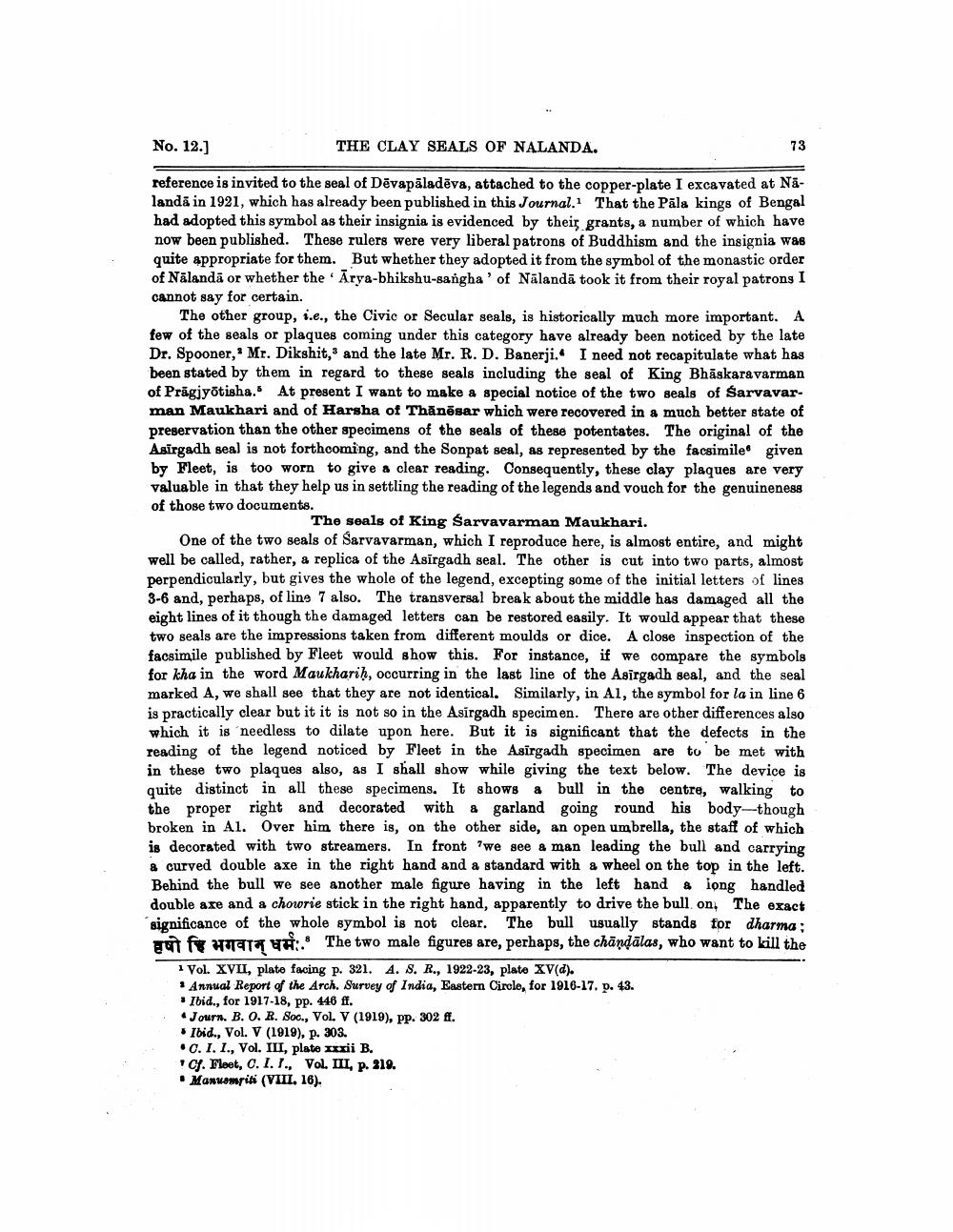________________
No. 12.]
THE CLAY SEALS OF NALANDA.
reference is invited to the seal of Devapaladēva, attached to the copper-plate I excavated at Nālanda in 1921, which has already been published in this Journal. That the Pāla kings of Bengal had adopted this symbol as their insignia is evidenced by their grants, a number of which have now been published. These rulers were very liberal patrons of Buddhism and the insignia was quite appropriate for them. But whether they adopted it from the symbol of the monastic order of Nālandā or whether the Arya-bhikshu-sangha' of Nalanda took it from their royal patrons I cannot say for certain.
The other group, i.e., the Civic or Secular seals, is historically much more important. A few of the seals or plaques coming under this category have already been noticed by the late Dr. Spooner, Mr. Dikshit, and the late Mr. R. D. Banerji. I need not recapitulate what has been stated by them in regard to these seals including the seal of King Bhaskaravarman of Pragjyotisha. At present I want to make a special notice of the two seals of Sarvavarman Maukhari and of Harsha of Thanesar which were recovered in a much better state of preservation than the other specimens of the seals of these potentates. The original of the Asirgadh seal is not forthcoming, and the Sonpat seal, as represented by the facsimile given by Fleet, is too worn to give a clear reading. Consequently, these clay plaques are very valuable in that they help us in settling the reading of the legends and vouch for the genuineness of those two documents.
73
The seals of King Sarvavarman Maukhari.
One of the two seals of Sarvavarman, which I reproduce here, is almost entire, and might well be called, rather, a replica of the Asirgadh seal. The other is cut into two parts, almost perpendicularly, but gives the whole of the legend, excepting some of the initial letters of lines 3-6 and, perhaps, of line 7 also. The transversal break about the middle has damaged all the eight lines of it though the damaged letters can be restored easily. It would appear that these two seals are the impressions taken from different moulds or dice. A close inspection of the facsimile published by Fleet would show this. For instance, if we compare the symbols for kha in the word Maukhariḥ, occurring in the last line of the Asirgadh seal, and the seal marked A, we shall see that they are not identical. Similarly, in Al, the symbol for la in line 6 is practically clear but it it is not so in the Asirgadh specimen. There are other differences also which it is needless to dilate upon here. But it is significant that the defects in the reading of the legend noticed by Fleet in the Asirgadh specimen are to be met with in these two plaques also, as I shall show while giving the text below. The device is quite distinct in all these specimens. It shows a bull in the centre, walking to the proper right and decorated with a garland going round his body-though broken in Al. Over him there is, on the other side, an open umbrella, the staff of which is decorated with two streamers. In front we see a man leading the bull and carrying a curved double axe in the right hand and a standard with a wheel on the top in the left. Behind the bull we see another male figure having in the left hand a long handled double axe and a chowrie stick in the right hand, apparently to drive the bull on. The exact significance of the whole symbol is not clear. The bull usually stands for dharma;
8
f. The two male figures are, perhaps, the chandalas, who want to kill the
1 Vol. XVII, plate facing p. 321. A. S. R., 1922-23, plate XV(d).
Annual Report of the Arch. Survey of India, Eastern Circle, for 1916-17. p. 43.
Ibid., for 1917-18, pp. 446 ff.
Journ. B. O. R. Soc., Vol. V (1919), pp. 302 ff.
Ibid., Vol. V (1919), p. 303.
C. I. I., Vol. III, plate xxxii B.
T Cf. Fleet, C. I. I., Vol. III, p. 219.
• Manusmriti (VIII. 16).




